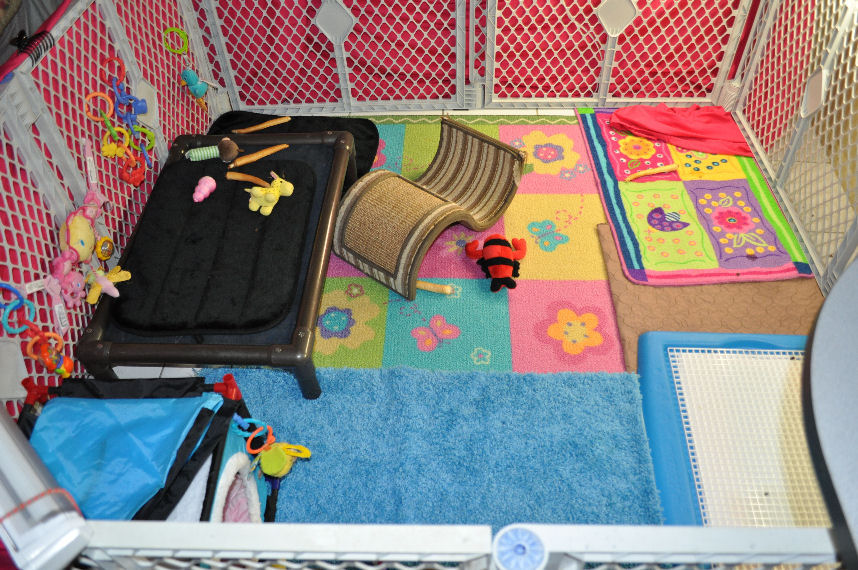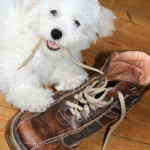A good solution to this is a puppy Exercise Pen. It gives them a safe environment when I cannot monitor them as well as teaches them what their boundaries are. The Exercise Pen is either metal or plastic sides (I prefer the plastic pens because they are more sturdy) that the puppy will be confined in but yet have the ability to “learn”. I put a soft bed or a Pipe Dreams bed, chews, soft toys to cuddle with, water bottle affixed to side of pen, food bowl affixed to side of pen (puppies like to tip bowls over and play in their water), and a puppy potty pad with a plastic grate on top to deter the puppy from shredding the pad. Depending on each individual puppy, at nighttime, I will either put the puppy in a crate appropriate for their size with bedding, soft toy and a little bedtime “cookie” or leave them in the puppy Exercise Pen with access to an open door crate.
Very important to remember for potty training is NO food – NO water throughout the night (but of course exceptions must be made for the smaller puppies – they may need access to food/water 24 hours a day to avoid hypoglycemia).
Puppies can get into lots of trouble if they are left unsupervised, so it is necessary to put them in a confined area to keep them safe. This is just a temporary place until the puppy is older, less mischievous and hopefully housebroken!
Please put your pup in an environment it can’t destroy. Puppies are too immature to handle temptations. Depending on the breed, most dogs begin to gain the maturity to handle short stints with mild temptations when they’re about 6 months old. Consider the analogy with a baby, where you keep it in a crib, stroller, or pen if you are not holding it.
It is essential to puppy-proof your home. You should think of it in the same way as child-proofing your house but be more thorough about it. Puppies are smaller and more active than babies and have sharp teeth and claws. Things of especial concern are electric wires. If you can get through the puppy stages without having your pup get a shock from chewing a wire you are doing a great job! When puppy proofing your home, get down on your hands and knees (or lower if possible) and consider things from this angle. What looks enticing, what is breakable, what is sharp, etc. The most important things are watching the puppy and, of course, putting the puppy in the exercise pen when you can’t watch it.
Another step in puppy proofing is house proofing the puppy. Teach it what is and isn’t chewable. The single most effective way to do this is by having a ready supply of chewable items on hand. When the puppy starts to chew on an unacceptable item (be it a chair, rug, and especially the human hand), remove the item from the puppy’s mouth with a stern, “NO!” and replace it with a chew toy and praise the puppy for playing with the toy. If you are consistent about this, the puppy will get the idea that only the things you give it are to be chewed on! Don’t stint on the praise, and keep the “No!” to a single calm, sharp noise — don’t yell or scream the word.
There are some products that can help make items unpalatable and thus aid in your training. Bitter Apple imparts a bitter taste to many things without staining, etc. You should not depend on these products to keep your puppy safe, but use them as a training aid.
A short checklist:
* Breakables up out of reach
* All wiring and cords put out of reach behind furniture, or encased in hard plastic flexible tubing (available at hardware stores, can be cut to size) to slow puppy down
* Anything small enough to be swallowed (pennies, bounce balls, shoelaces, bits of paper, socks, nuts, bolts, wire) removed from the floor
* Block access behind furniture wherever possible
* Put children’s toys and stuffed animals away
Many times I have seen puppies run around with things in the mouth and wondered where in the world did you get that.
Above all else, enjoy your new puppy in the safe environment you created for him. If you feel your home and yard are “child proof” then your puppy should be safe there, too. Remember to supervise your puppy closely when you first bring him home to make sure you have not missed something dangerous to his safety.
One last word of warning is to NEVER leave your puppy in your backyard when you are not at home to supervise him. You could come home and find him missing or badly injured. Please take care to ensure his safety whether you are home or away.


